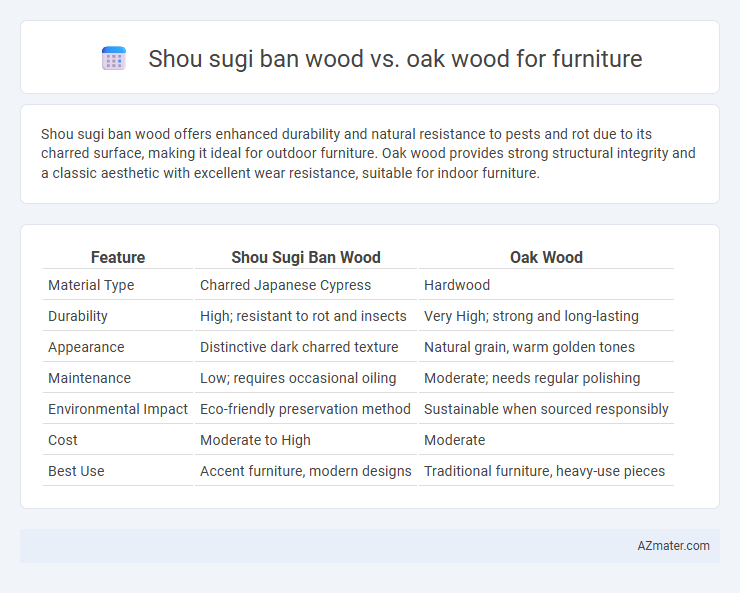Shou sugi ban wood offers enhanced durability and natural resistance to pests and rot due to its charred surface, making it ideal for outdoor furniture. Oak wood provides strong structural integrity and a classic aesthetic with excellent wear resistance, suitable for indoor furniture.
Table of Comparison
| Feature | Shou Sugi Ban Wood | Oak Wood |
|---|---|---|
| Material Type | Charred Japanese Cypress | Hardwood |
| Durability | High; resistant to rot and insects | Very High; strong and long-lasting |
| Appearance | Distinctive dark charred texture | Natural grain, warm golden tones |
| Maintenance | Low; requires occasional oiling | Moderate; needs regular polishing |
| Environmental Impact | Eco-friendly preservation method | Sustainable when sourced responsibly |
| Cost | Moderate to High | Moderate |
| Best Use | Accent furniture, modern designs | Traditional furniture, heavy-use pieces |
Introduction: Shou Sugi Ban Wood vs Oak Wood for Furniture
Shou Sugi Ban wood, a Japanese technique of charring cedar, offers exceptional durability and weather resistance, making it ideal for outdoor furniture and modern interiors. Oak wood, known for its strength and classic grain patterns, provides timeless elegance and robust performance in both traditional and contemporary furniture designs. Comparing Shou Sugi Ban and Oak highlights differences in texture, longevity, maintenance, and aesthetic appeal for furniture applications.
What is Shou Sugi Ban Wood?
Shou sugi ban wood is a traditional Japanese technique where wood, typically cedar, is charred to create a durable, weather-resistant surface with a unique textured appearance. This process enhances resistance to rot, insects, and fire, making it ideal for outdoor and accent furniture, contrasted with oak wood's natural hardness and classic grain suited for indoor furniture. Shou sugi ban's deep charred finish provides a distinctive aesthetic and longevity not naturally present in untreated oak wood.
Characteristics of Oak Wood
Oak wood is renowned for its exceptional strength, durability, and dense grain, making it a favored choice for furniture that requires long-lasting performance. Its natural resistance to wear and insect damage, along with its ability to take stains and finishes evenly, allows for versatile styling and a rich, warm aesthetic. Compared to Shou sugi ban wood, which is charred for weather resistance, oak offers a more traditional, robust texture ideal for both indoor and outdoor furniture applications.
Durability Comparison: Shou Sugi Ban and Oak
Shou Sugi Ban wood, treated through a traditional Japanese charring technique, offers enhanced durability by making the surface fire-resistant, water-repellent, and insect-resistant, which significantly extends its lifespan compared to untreated woods. Oak wood, known for its strong grain and density, provides excellent natural durability, resistance to wear, and structural strength, making it a reliable choice for furniture. While oak maintains stability and robustness over time, Shou Sugi Ban's charred coating adds an extra protective layer that excels in resisting environmental damage and decay.
Aesthetic Differences: Appearance and Texture
Shou sugi ban wood features a distinctive charred surface that enhances its rich, deep black tones and creates a textured, grooved appearance, offering a bold, modern aesthetic for furniture. Oak wood presents a classic look with a natural, warm color palette ranging from light tan to medium brown, showcasing a smooth to coarse texture with prominent grain patterns that exude traditional elegance. The contrast between Shou sugi ban's striking, tactile finish and Oak's timeless, natural grain allows for diverse design choices depending on the desired visual impact and tactile experience.
Maintenance and Care Requirements
Shou sugi ban wood requires minimal maintenance due to its charred surface, which naturally resists rot, insects, and weathering, making it ideal for durable outdoor furniture. Oak wood demands regular sealing or oiling to prevent moisture damage, cracking, and warping, especially when exposed to varying humidity and temperature conditions. Both woods benefit from periodic cleaning, but shou sugi ban's unique carbonized finish reduces the frequency and intensity of maintenance compared to traditional oak.
Environmental Impact and Sustainability
Shou sugi ban wood, a traditional Japanese technique of charring wood surfaces, offers enhanced durability and natural resistance to pests, reducing the need for chemical treatments and prolonging furniture lifespan, which contributes positively to sustainability. Oak wood, while highly durable and widely used in furniture making, often requires more intensive resource input and chemical finishes for pest resistance and maintenance, impacting its environmental footprint. Choosing Shou sugi ban wood supports eco-friendly practices by utilizing a natural preservation method that minimizes chemical reliance and promotes long-term durability.
Cost and Accessibility
Shou sugi ban wood, a Japanese technique of charring cedar, tends to be more expensive than oak due to its specialized processing and limited availability outside of niche markets. Oak wood is widely accessible globally, offering a more affordable and readily available option for furniture makers and consumers. The cost disparity often reflects the artisanal value of shou sugi ban's durability and unique aesthetic compared to the traditional strength and versatility of oak.
Best Uses in Furniture Design
Shou sugi ban wood, renowned for its charred surface and exceptional durability, excels in outdoor furniture and accent pieces requiring weather resistance and a unique textured appearance. Oak wood, prized for its strength, fine grain, and classic warmth, is ideal for traditional and contemporary indoor furniture such as tables, chairs, and cabinetry. Both materials offer distinct aesthetics and functional benefits, with shou sugi ban favoring modern, rustic styles and oak supporting timeless, versatile designs.
Conclusion: Which Wood is Better for Furniture?
Shou sugi ban wood offers exceptional durability, fire resistance, and a striking charred aesthetic, making it ideal for modern, weather-resistant furniture. Oak wood provides timeless strength, natural grain beauty, and excellent workability, suited for classic and sturdy indoor pieces. Choosing between them depends on whether longevity and unique appearance (Shou sugi ban) or traditional elegance and versatility (oak) are prioritized for the furniture project.

Infographic: Shou sugi ban wood vs Oak wood for Furniture
 azmater.com
azmater.com